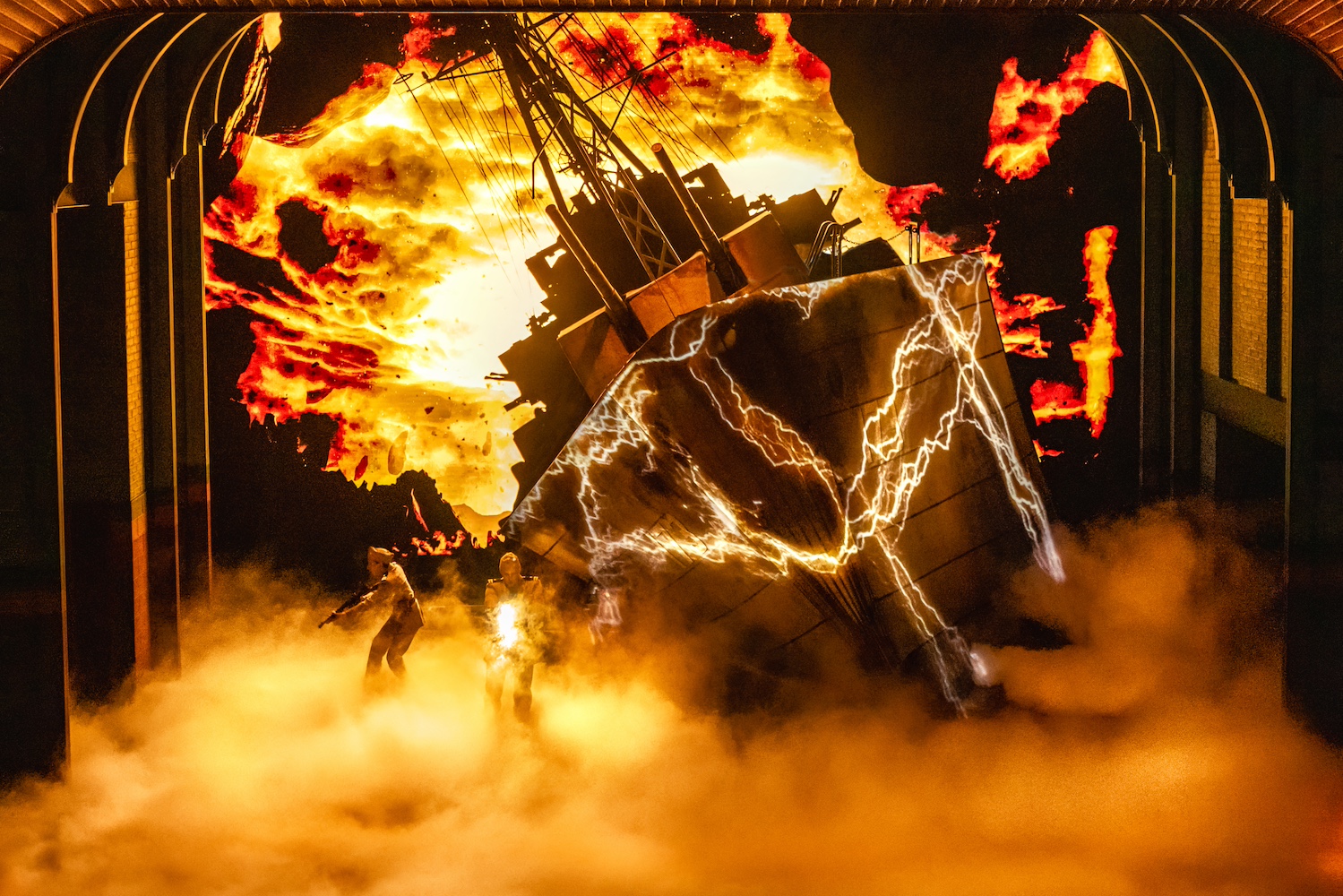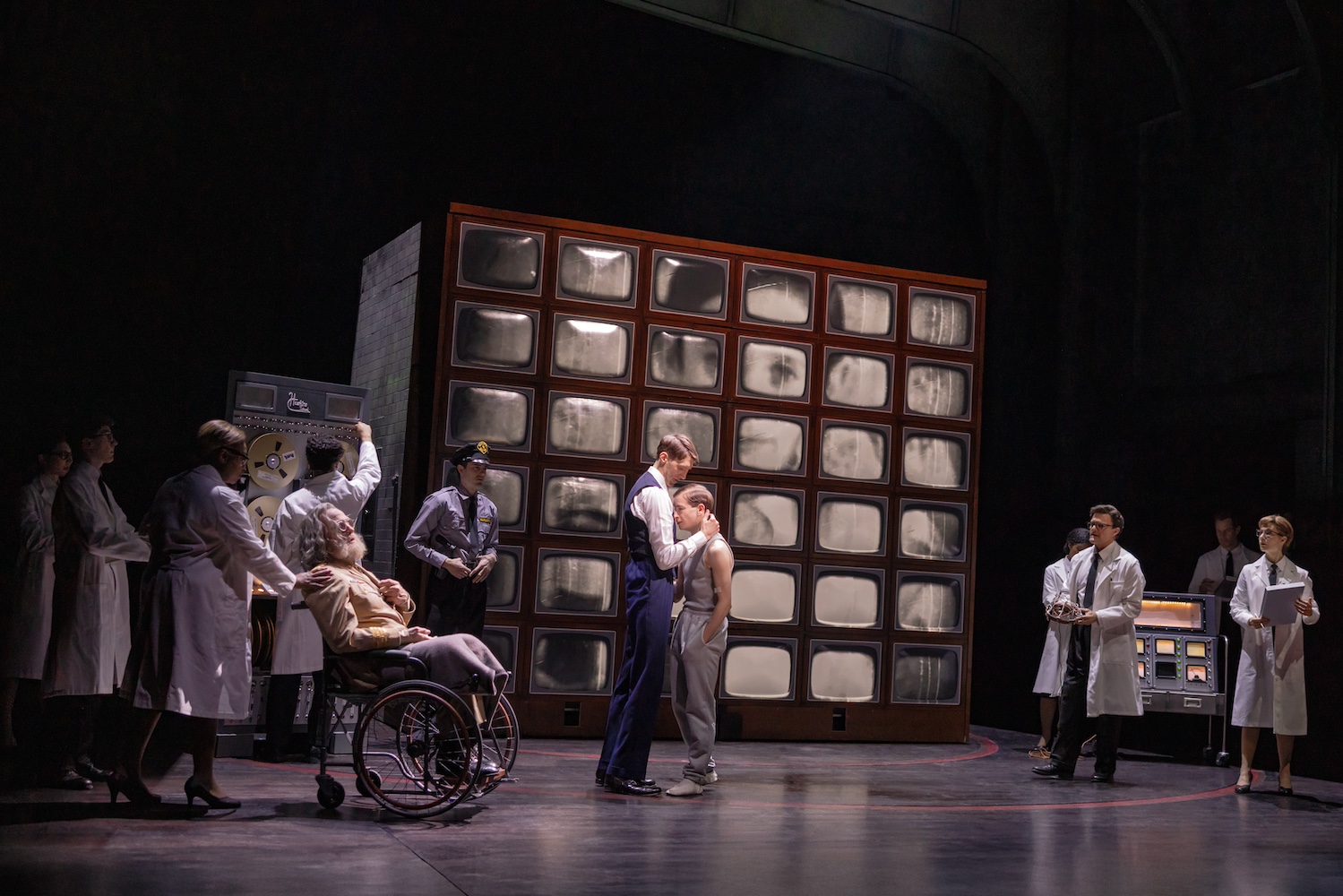****/***** (four out of five stars)
Bursting onto the scene in 2016 with a “Steven Spielberg meets Stephen King” sensibility, “Stranger Things” has been a flagship hit for Netflix. A spinoff of some sort was inevitable, though few onlookers would have predicted that it would come in the form of a Broadway show. As its name suggests, Stranger Things: The First Shadow, now playing at the Marquis Theatre, is an origin story for Hawkins, Indiana’s status as ground zero for monstrous abominations clawing through the barrier between our world and what the Netflix show dubs “the Upside-Down.” The show’s secondary characters, whom we have already met as defeated, traumatized, or narrow-minded adults in middle age, take center stage here, in 1959, as fresh-faced, creative youths, ready to storm the establishment’s barricades–and to figure out who, or what, is committing mysterious, troubling crimes against the local pet population.
Henry Creel (Louis McCartney, who originated the role on London’s West End), the new kid in town, arrives with crushing emotional baggage, with his clearly terrified mother (Rosie Benton) reminding him to tell himself, “It’s not real–I’m normal.” This refusal to address what is actually happening (whatever that might be) works about as well as you’d expect, as Henry slips further and further into his own world, even as he denies its existence. McCartney plays Henry with an intensity that slides from the spectral to the demonic, his slight frame trembling with the overwhelming power that courses through it.

Around Henry whirls the everyday turmoil of adolescent life, with crushes, curfews, school plays, identity crises, and assorted bits of business that ground Henry’s existential struggle within a heightened high school context. The students’ costumes (Brigitte Reiffenstuel) are beautifully period-appropriate when taken one at a time; en masse, they help create the super-saturated world these characters are moving through. All of the play’s teenagers are tuned to an extra-high frequency: Joyce Maldonado (Alison Jaye) practically vibrates as she tries to corral her drama club comrades into a new play; and a young Jim Hopper (Burke Swanson) exudes pure rebelliousness. Gabrielle Neveah is intense in her vulnerability as Patty Newby, Henry’s only friend. On a meta level, as one of the few unfamiliar names for fans of the TV show, Patty’s journey and ultimate fate are compelling in the way that a foregone conclusion can never be. Alex Breaux, as Dr. Brenner, slips from paternal regard to ice-cold opportunism and back again.
The set design (Miriam Buether, with lighting design by Jon Clark, illusions and visual effects by Jamie Harrison and Chris Fisher, and video and visual effects by 59) is, in a word, astonishing. The audience feels completely immersed in this world, whether the scene takes place in a school bathroom, dingy attic, gleaming laboratory, plain church, hallucinatory Las Vegas stage, World War II battleship, suburban street after dark, or hellscape that breeds demons that prey on humans. The stagecraft continually jolts and destabilizes the audience, with jump scares, impossible body doubling, and an exquisite slow-motion sequence. Projections and screens provide dense, convincing detail.
Stephen Daldry’s and Justin Martin’s direction toggles between the flat-out horror of Henry losing himself to dark forces, and the madcap adventures of the kids who have no idea what is going on here, but plan to find out, with impeccable comic timing. The deftly handled tonal whiplash swings through the very end of the show, which ends on a gasp–and then a laugh.

The script (Kate Trefry) zips along with impressive energy, hitting each beat with enough force to catapult into the next scene with a shock or a punchline. The 1959 setting is not quite fleshed out with the same care and attention to detail as the original’s mid-80s milieu–at one point, a character exclaims, “Sex, drugs, and Elvis Presley!”, at which point they may as well start doing TikTok challenges–but no one is here for verisimilitude, and if that joke didn’t land, there’s another one, or a genuinely upsetting moment, or a new visual spectacle, right behind it. There are gestures at a thesis statement: a play within the play is described as being about the destructive power of fear, and Patty asks Henry, “What if the thing you hate about yourself isn’t a mistake? What if it’s a miracle?” That doesn’t quite hang together with the rest of the happenings here, but it’s something to keep in mind for future generations in Hawkins.

Stranger Things: The First Shadow has a fine line to tread: it has to appeal to fans of the Netflix show, while being accessible enough to newcomers that they don’t leave bewildered and resentful. It does an admirable job on both counts (Joyce onstage with a gadget bedecked in Christmas lights is a delightful Easter egg). Though some moments necessarily hit harder with additional context, anyone who is familiar with the basic Stranger Things premise will have no problem getting lost in the world of Hawkins here.
Stranger Things: The First Shadow. Open run at the Marquis Theatre (210 West 46th Street, between Broadway and Eighth Avenue).












